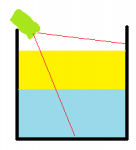Dear All,
First of all i am new to the forum, and i want to say hello to all !! , and i am looking for some guidance, i have a possible project that requieres measure two immiscible liquids in a tank, i just need to measure the height of the liquid, I know that you can use lasers and reflection to measure one liquid, but one in top of another ?
, and i am looking for some guidance, i have a possible project that requieres measure two immiscible liquids in a tank, i just need to measure the height of the liquid, I know that you can use lasers and reflection to measure one liquid, but one in top of another ?
For example water and gasoline, and my question is if this is possible using lasers. Sorry to be so straigh forward but the real thing is that in my country there is no one to ask about lasers and possible applications.
Hope someone can point me to the right direction, just need the main idea in order to have somewhere to start investigating.
Thanks !!
First of all i am new to the forum, and i want to say hello to all !!
For example water and gasoline, and my question is if this is possible using lasers. Sorry to be so straigh forward but the real thing is that in my country there is no one to ask about lasers and possible applications.
Hope someone can point me to the right direction, just need the main idea in order to have somewhere to start investigating.
Thanks !!




